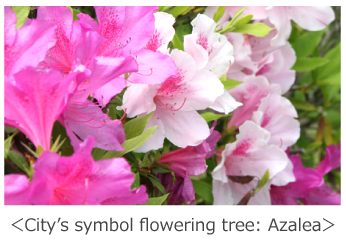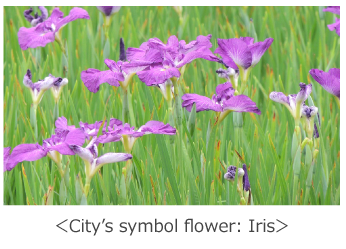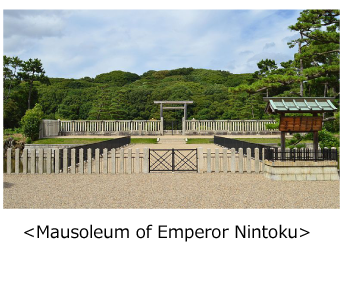
Information on Sakai
Location
Sakai faces Osaka Bay and is located in the south of the city of Osaka.

Population
Sakai is the second largest city in Osaka Prefecture following the city of Osaka in terms of both population and area size. The population of Sakai was approximately 840,000 as of April 2016, and Sakai exceeded Yamanashi Prefecture, Saga Prefecture, Fukui Prefecture, Tokushima Prefecture, Kochi Prefecture, Shimane Prefecture, and Tottori Prefecture in population. Sakai is ranked 14th among all ordinance-designated cities nationwide in terms of population.

Product Shipments
Sakai was ranked ninth following the city of Nagoya with an annual shipment value of 3,225.5 billion yen in 2013 produced from the total industrial production processes. Sakai shows a strong presence as a city of industrial production.

The Name of Sakai
The name “Sakai” already appeared in the Heian period (from 794 to 1185). It is said that the name “Sakai,” which literally means “border” in Japanese, was originated from the fact that the area was developed in the border of three ancient provinces, i.e., Settsu, Kawachi, and Izumi. Sakai’s city emblem, a combination three identical kanji characters for “city” symbolizing its location, was adopted in June 1895.

City’s Symbol Flowering Tree, Flower, and Bird
The azalea, iris, and shrike are Sakai’s symbol flowering tree, symbol flower, and symbol bird, respectively.

The azalea was adopted as Sakai’s symbol flowering tree under the voting of residents in April 1989 in commemoration of the 100th anniversary of the municipal assembly. A large number of people visit Asakayama Park (the site of the Asakayama Water Purification Plant), one of the top 100 green areas in Osaka, in the best season for viewing azalea blossoms

The iris was adopted as Sakai’s symbol flower under the voting of residents in April 1989 in commemoration of the 100th anniversary of the municipal assembly. The flower that has been cultivated for 1250 years is worthy as Sakai’s symbol of its history and tradition.
 The shrike was adopted as Sakai’s symbol bird under the voting of residents in April 1989 in commemoration of the 100th anniversary of the municipal assembly. It is said that a local place in Sakai called “Mozu,” which literally means “shrike” in Japanese, was named after an episodic legend related to a shrike and the Mausoleum of Emperor Nintoku, another symbol of Sakai.
The shrike was adopted as Sakai’s symbol bird under the voting of residents in April 1989 in commemoration of the 100th anniversary of the municipal assembly. It is said that a local place in Sakai called “Mozu,” which literally means “shrike” in Japanese, was named after an episodic legend related to a shrike and the Mausoleum of Emperor Nintoku, another symbol of Sakai.
Roots of Industrial Production


Sakai has the Mozu Kofungun (a group of a large number of tumuli) including the Mausoleum of Emperor Nintoku, the largest ancient tomb in Japan. Efforts are under way toward the registration of the Mozu Kofungun and the Furuichi Kofungun (a group of a large number of tumuli spreading in the south of Sakai) as World Heritage sites. The Suemura group of kiln sites known as Japan’s largest production area of sueki (the common pottery of Japan in ancient times) spread in the hilly area from Sakai to Kishiwada in the Kofun period (from around AD 250 to 538). Sakai, which flourished in the ceramic industry, became the center of the metal foundry industry in medieval times. In the age of provincial wars in Japan, founders with excellent technology started manufacturing guns in Sakai, which was a production place of swords and weapons as well, and built a monopoly system. Their sophisticated metal processing technologies have been inherited from generation to generation, leading to the production of bicycles and various metal parts since modern times. It can be said that the roots of industrial production that support today’s Sakai is traced back to the Kofun period far away over a period of 1600 years in the past. Businesses in two types of major industries, i.e., the metal product manufacturing industry and the production machinery and equipment manufacturing industry, still occupy a large part of all business operations in Sakai, and Sakai functions as an important industrial center in the Osaka area.
Harbor City: Sakai

A harbor city is another feature of Sakai. Sakai, which faces Osaka Bay, has developed as a fishing port since old times. In the 15th century, the Muromachi shogunate started marine trades with Ming Dynasty in China. Hyogo Port in Kobe was originally used for the departure and arrival of trading ships. The port, however, was destroyed by the turbulence of the Onin-Bunmei Wars, and Muromachi shogunate started using Sakai Port. Sakai Port became the center of marine trades with Ming Dynasty. Eventually, Sakai Port underwent a major transformation to an international port as a marine trade base during the Ryukyu and Nanban trade period and entered into its golden age. Sakai was called Oriental Venice in those days and Sakai merchants meant overseas trading merchants.
In Sakai, wealthy merchants led an autonomous organization called “egoshu” and managed urban governance not based on the control of the shogunate. Sen no Rikyu, the historical figure considered to have had the most profound influence on the Japanese tea ceremony, was a member of the egoshu. He established the unique tea ceremony culture, the essence of which lies in the aesthetic sense of “wabi-sabi” (underplayed and modest, the kind of quiet, undeclared beauty that waits patiently to be discovered) and the spirit of “motenashi” (hospitality). Sakai as the center of economy and culture at its heyday was leading Japan. Later, Japan became under the rule of the Tokugawa shogunate, and Sakai, which had prospered as an overseas trade port city, followed the path of decline while the shogunate turned into a seclusion policy. However, Sakai’s function as a logistics port was never lost. After the coastal industrial area in the southern part of Osaka was created in the latter half of the 1950s, the volume of cargo handled at Sakai Port increased greatly. In 1969, Sakai Port was integrated with Senboku Port into Sakai-Senboku Port, which was designated as a specific major port. Furthermore, it was designated as one of the 18 international hub ports in Japan in 2011, and the importance of the port is increasing year by year.
passed on to the staff of Tanaka Sangyo.

